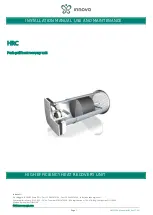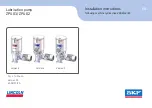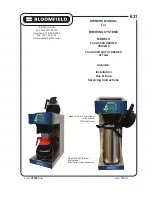
Rev 8.0/6-13
30
MRTALPCH6-DC: #35054
V
ACUUM
S
WITCH
A
DJUSTMENT
Vacuum Switch Function
This vacuum lifter is equipped with a vacuum switch, which controls the low vacuum warning
buzzer, vacuum lift light and vacuum pump (see OPERATING FEATURES for location of vacuum
switch): The power switch activates the warning buzzer and the pump, which evacuates the
vacuum pads. After the lifter attains a vacuum level sufficient for lifting the maximum load
weight (hereafter, “minimum lifting level”), the vacuum switch automatically turns off the pump
and the warning buzzer
23
while it turns on the lift light. In order to maintain sufficient vacuum,
the vacuum switch automatically turns on the pump and warning buzzer again (while it turns off
the lift light) before vacuum decreases to a level that is lower than the minimum lifting level.
Conditions Requiring Readjustment
At the factory, the vacuum switch is set to maintain the minimum vacuum level specified for the
Load Capacity (see SPECIFICATIONS). However, shipping vibrations or shocks, normal wear, or
other conditions may adversely affect this adjustment. Periodically verify the switch adjustment
by comparing how the vacuum pump, low vacuum warning buzzer and vacuum lift light function
in relation to the vacuum level registered on the vacuum gauges, as follows:
• If the pump and the warning buzzer do not
turn off or the lift light does not turn on
after
vacuum increases to a level much
higher than the minimum lifting level, the vacuum switch
may be adjusted to maintain a lower vacuum level. Otherwise, the pump would continue to
run unnecessarily after the lifter has attained sufficient vacuum to lift the maximum load
weight.
• If the pump and the warning buzzer do not
turn on or the lift light does not turn off
before
vacuum decreases to a level
lower than the minimum lifting level, the vacuum switch
must
be adjusted to maintain a higher vacuum level
.
24
Otherwise, the lifter would not
maintain sufficient vacuum to lift the maximum load weight.
23
When using the lifter at high elevations, reduced atmospheric pressure may prevent the vacuum generating system from
attaining the vacuum level set at the factory. In this case, the pump would continue to run and the warning buzzer would sound
an alarm continuously. If the ability to lift the maximum load weight is not required, the operator can adjust the vacuum switch
to maintain a lower vacuum level, allowing the pump to cycle normally. However, be advised that
lifting capacity decreases
proportionally with decreasing vacuum
, based on the vacuum level specified for the Load Capacity (see SPECIFICATIONS).
For example, if a lifter's Load Capacity is rated at 16" Hg [-54 kPa], lifting capacity decreases by 6.25% for each inch of Hg
subtracted from (or for each 3.4 kPa added to) the vacuum level.
Always maintain a minimum vacuum level of 10" Hg
[-34 kPa]
, regardless of the vacuum level specified for the original Load Capacity. In addition, lifter markings should be
adjusted to reflect the revised Load Capacity and the vacuum gauges should be marked to indicate the revised minimum lifting
level.
24
In order to observe lifter functions while vacuum is decreasing, it may be necessary to create a controlled leak in the vacuum
system (eg, by breaking the seal between one or more vacuum pads and the test surface). Since the lifter is equipped with a
Dual Vacuum System, a leak should be introduced in each of the 2 vacuum circuits, which can be identified by differently colored
vacuum hoses.
Summary of Contents for Powr-Grip MRTALPCH610DCO
Page 2: ......
Page 36: ...Rev 8 0 6 13 34 MRTALPCH6 DC 35054...







































